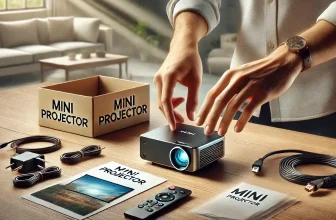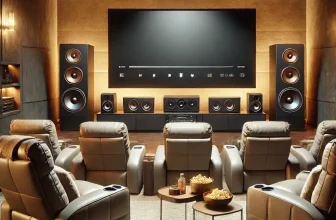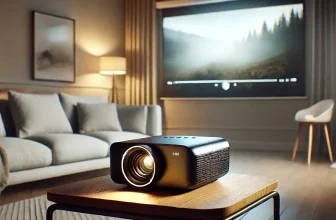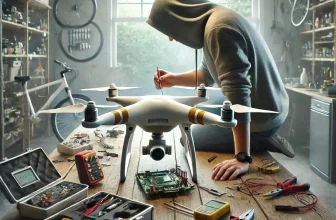How to Buy a Drone: A Complete Shopping Guide
Each product is chosen independently by our editors. Purchases made through our links might earn us a commission at no extra cost to you!
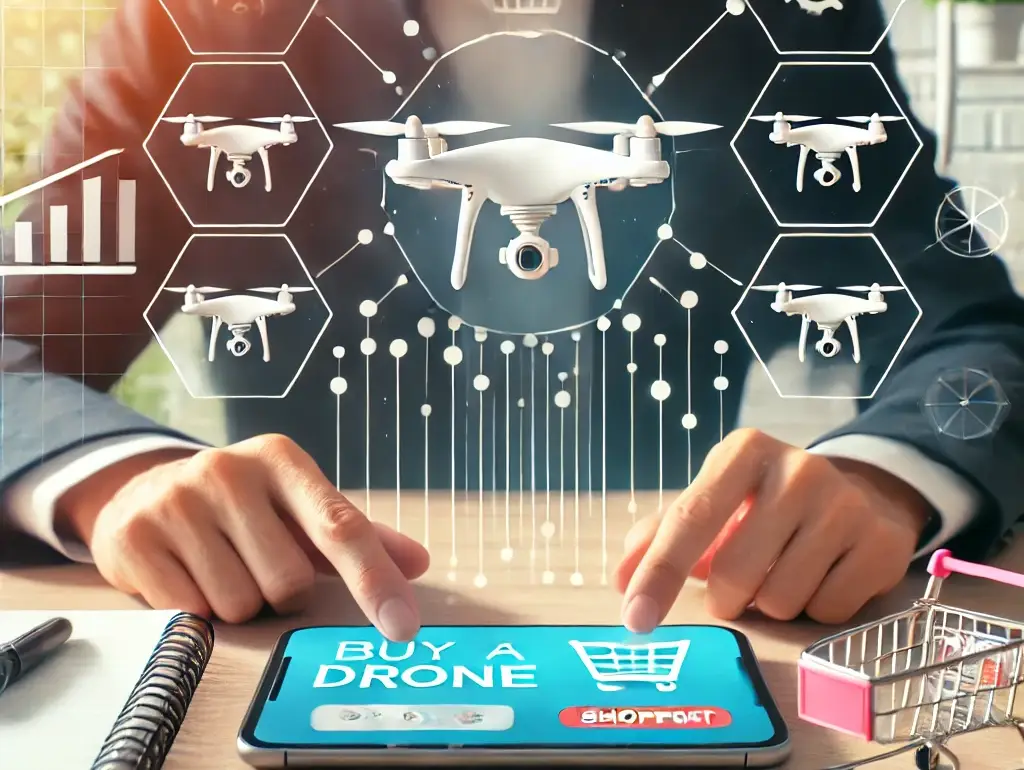
Introduction
Drones have become increasingly popular, offering endless possibilities for photography, videography, and entertainment. However, with countless options available, how to buy a drone can feel overwhelming, especially for first-time buyers. This guide provides the best drone buying tips to help you navigate the purchasing process, create a drone shopping checklist, and identify your needs. We’ll also cover key factors to consider for drones, ensuring you make an informed decision. Whether you’re exploring drone buying for beginners or upgrading as a professional, this guide is tailored for you.
Table of Contents
Identify Your Personal Needs
Investing in a drone is not just an expense—it’s an opportunity to explore cutting-edge technology or elevate your work efficiency. However, to select the right drone, you need to clearly identify your purpose and personal needs. This guide will help you make an informed decision with updated recommendations.
1. Define the Purpose of Your Drone
Every drone serves a specific purpose, and understanding your requirements is key to choosing the right model. Below are some common categories of drone usage, along with recommendations based on your needs.
1.1 Photography and Videography
If your goal is capturing stunning aerial photos and high-quality videos, you’ll need a drone with advanced camera capabilities and stabilization features. Look for drones with:
- High-resolution cameras (4K or higher): Essential for professional-grade footage.
- Advanced stabilization systems: To ensure smooth, shake-free videos, especially in windy conditions.
- Professional shooting modes: These allow for more creative control over your shots, including slow motion, timelapse, and panoramic modes.
Recommendations:
- DJI Air 3: This drone comes with dual 1/1.3-inch CMOS cameras that support 4K HDR video recording and offer up to 46 minutes of flight time. It’s a great choice for semi-professionals and professionals alike, combining impressive image quality with long battery life.
- DJI Mini 4 Pro: Compact yet powerful, this model features a 1/1.3-inch sensor, 4K/60fps HDR video, and omnidirectional obstacle sensing. It’s perfect for content creators who need a portable solution with high-quality camera performance.
1.2 Recreational Use
For beginners or casual hobbyists, choosing a simple, budget-friendly drone is ideal. These drones are designed for easy operation and fun flying, without overwhelming features. Look for drones with:
- Easy-to-use controls: Simple app-based or remote control systems for hassle-free flying.
- Affordable pricing: Perfect for those who want to experience flying without a large investment.
- Basic cameras or no cameras: Sufficient for casual flying and beginner exploration.
Recommendations:
- Ryze Tello: This compact and budget-friendly drone is controlled via an easy-to-use app. It’s ideal for beginners and kids, offering a fun flying experience without breaking the bank.
- Holy Stone HS720G: Equipped with a 4K camera, GPS, and 26 minutes of flight time, this drone offers a solid upgrade from entry-level models while remaining easy to operate for recreational flying.
1.3 Professional Work
Professionals involved in mapping, inspections, or cinematography require drones with premium features. Look for drones with:
- Superior cameras (4K or 5K resolution): For high-definition imaging required in commercial projects.
- Longer flight times: To cover large areas or capture more footage during a single flight.
- Advanced sensors and stabilization: To ensure accurate, stable flying, especially in challenging environments.
Recommendations:
- DJI Mavic 3 Pro: Featuring a triple-camera system, 4/3 CMOS sensor, and 5.1K video recording, this drone delivers professional-grade image quality, with up to 43 minutes of flight time. It’s perfect for aerial photography, mapping, or surveying.
- DJI Inspire 3: A high-end drone built for film production, equipped with an X9 Air 8K camera and RTK (Real-Time Kinematic) for precise positioning. This model is ideal for filmmakers and professional cinematographers.
Learn more about DJI Mavic 3 Pro and DJI Inspire 3 on the official website.
1.4 Learning and Experimenting
For those interested in learning more about drones, experimenting with drone technology, or developing coding skills, educational drones are a great starting point. These drones often support programming and AI features that are ideal for young learners and tech enthusiasts. Look for drones with:
- Programmable features: For hands-on learning experiences in coding and AI.
- Educational tools: Apps or kits designed to teach drone operations and programming.
Recommendations:
- DJI Robomaster TT: A versatile, advanced educational drone that supports AI and coding education. Perfect for students or hobbyists looking to learn more about drone technology and programming.
Check DJI Robomaster TT on the official website.
2. Assess Your Skill Level
Choosing a drone that aligns with your skill level is crucial for ensuring a smooth flying experience and safety. Here’s a guide based on your level of experience:
2.1 Beginners:
Look for drones with user-friendly features:
- Auto-pilot support with GPS: This feature helps the drone stabilize and follow a preset path, reducing the likelihood of errors made by the pilot.
- Obstacle avoidance: Automatic obstacle detection and avoidance to prevent collisions with objects in the drone’s path.
- Simple app-based controls: User-friendly controls via a smartphone app, making it easier for beginners to fly.
Examples: DJI NEO, Ryze Tello.
Analysis: These drones are perfect for beginners because they offer easy controls, GPS stability, and obstacle avoidance, allowing users to enjoy flying without feeling overwhelmed by complex features.
2.2 Intermediate:
Look for drones with more advanced features:
- Adjustable flight settings: Customize flight parameters like speed, altitude, and flight modes for a more personalized experience.
- Longer flight times: Drones with extended battery life, allowing users to fly for longer periods.
- Better cameras: Higher-quality cameras for capturing better photos and videos.
Examples: DJI Air 3, Holy Stone HS720G.
Analysis: These drones are perfect for hobbyists who want to experiment with different flight modes, capture better imagery, and experience more advanced features beyond basic flying.
2.3 Advanced Users:
Look for drones with professional-grade features:
- High speed and flexibility: These drones are fast and agile, ideal for creative projects or professional work.
- Advanced sensors and 4K cameras: Drones with high-quality cameras and advanced sensors, offering exceptional image and video quality.
Examples: DJI Inspire 3, Mavic 3 Pro.
Analysis: Advanced users require drones with top-tier performance, excellent image quality, and the ability to perform complex maneuvers, making these models ideal for professionals in film production or creative industries.
3. Set a Realistic Budget
Setting a budget is essential when choosing a drone, as it determines the features and quality of the drone you can afford.
3.1 Under $200:
Choose basic drones with limited features: These drones are often simple and suitable for beginners or children, with basic cameras and shorter flight times.
Example: Ryze Tello.
Analysis: These drones are a good choice for those just starting out or for kids, as they offer basic functionality without the complexity of advanced features.
3.2 $200–$800:
Choose mid-range drones: These drones offer decent cameras, longer flight times, and more features, such as customizable flight settings and better stability.
Example: DJI Mini 4 Pro.
Analysis: With a budget of $200–$800, you’ll get a good balance of features, including better camera quality, longer battery life, and more advanced flying options suitable for more experienced hobbyists.
3.3 Above $800:
Choose high-end drones: Drones at this price point come with advanced features, such as 4K cameras, longer flight ranges, and superior sensors, making them ideal for professionals.
Examples: DJI Air 3, Mavic 3 Pro.
Analysis: High-end drones provide professional-grade performance and image quality, making them perfect for those who need reliable, high-performance drones for work or advanced hobbies.
4. Consider Your Flying Environment
The environment in which you plan to fly your drone plays a significant role in selecting the right drone. Different environments require specific features from the drone.
4.1 Urban Areas:
Choose compact, quiet drones with obstacle avoidance: These drones are designed to be small and maneuverable, ideal for navigating tight spaces and avoiding collisions in crowded urban settings.
Example: DJI Mini 4 Pro.
Analysis: Urban environments are often cluttered with buildings, trees, and other obstacles, so drones with obstacle avoidance and quiet operations are essential for safe flying.
4.2 Rural or Scenic Locations:
Choose drones with long battery life and range: These environments often require drones with extended flight times and longer transmission distances to explore open spaces.
Example: DJI Air 3.
Analysis: In rural or scenic locations, you’ll need drones with the ability to fly longer distances and stay in the air for extended periods, especially when exploring vast open spaces or capturing landscape photography.
4.3 Indoors:
Choose lightweight drones designed for indoor use: Drones for indoor flying should be lightweight, easy to control, and safe for flying in small spaces.
Example: DJI Neo.
Analysis: Indoor flying requires drones that are compact, easy to maneuver, and safe to operate in confined spaces, such as living rooms or gyms.
5. Think About Future Upgrades
Investing in drones that allow for upgrades is a smart decision, especially if you plan to continue flying drones long-term. Here are some potential upgrades to consider:
- Extra Batteries: If you want to extend your flight times, investing in extra batteries is a must.
- Improved Cameras: If you’re passionate about aerial photography, upgrading to a higher-quality camera can significantly enhance your photos and videos.
- Controllers or VR Goggles: A new controller or a pair of VR goggles can provide a more immersive flying experience.
Analysis: Future-proofing your drone with upgrades like extra batteries, improved cameras, or immersive control options will ensure that your drone remains relevant and versatile for years to come.
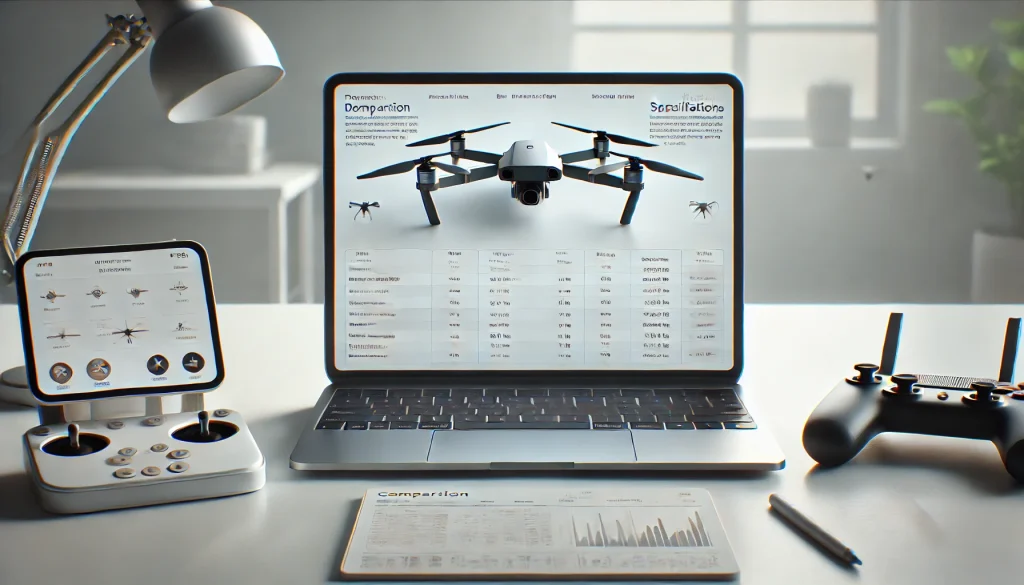
Learn more about the best drones for beginners in our detailed guide. Or you can read this detailed article about how to choose the best drone for photography on Bestbuy.
Key Factors to Consider When Buying a Drone
Selecting the right drone requires careful evaluation of key factors. By understanding these aspects, you’ll make an informed decision that aligns with your needs and avoids costly mistakes. Below are the essential factors to consider, updated with the latest drone models:
1. Camera Quality
The camera is a decisive feature for those prioritizing photography or videography. It directly impacts the quality of your content.
What to look for:
- Resolution: Higher resolutions (e.g., 4K or 5.4K) provide sharper and more detailed images. A 4K camera is recommended for professionals.
- Stabilization: Gimbal-stabilized cameras ensure smooth video recording by reducing shakiness.
- Frame Rates: Look for higher frame rates (e.g., 60fps or 120fps) for slow-motion shots.
- Field of View (FOV): A wider FOV captures more of the scene, ideal for landscapes.
Updated Example: If you’re a travel vlogger, a drone like the DJI Mini 4 Pro offers exceptional 4K HDR video and advanced stabilization, making it ideal for creating cinematic content.
2. Flight Time and Battery Life
Flight time determines how long you can fly your drone before recharging or replacing the battery.
What to consider:
- Standard Flight Time: Most drones offer 30–46 minutes on a single charge.
- Battery Swapping: Models with quick-swapping batteries are practical for extended use.
- Charging Speed: Fast-charging batteries reduce downtime.
Updated Example: For event shooting, the DJI Air 3 provides up to 46 minutes of flight time, offering flexibility to capture crucial moments.
Pro Tip: Always carry spare batteries to maximize your flight sessions.
3. Range and Signal Strength
The range of a drone determines how far it can fly from the controller while maintaining a reliable connection.
Range categories:
- Beginner Drones: Offer 100–300 meters, suitable for casual users.
- Advanced Drones: Can reach up to 10 kilometers, ideal for professional use.
- Signal Technology: Look for drones with strong signal transmission systems like OcuSync 3.0 for stable connections.
Updated Example: For landscape photography in remote areas, the DJI Mavic 3 Pro offers long-range signal transmission and precision GPS tracking for uninterrupted flights.
Safety Tip: Always maintain visual line-of-sight to avoid accidents, even with long-range drones.
4. Portability and Build Quality
Portability is crucial if you frequently travel or transport your drone.
What to consider:
- Compact Design: Foldable drones are easier to carry and store.
- Weight: Lightweight drones are more convenient but can be more affected by wind.
- Durability: High-quality materials help drones withstand minor crashes.
Updated Example: The DJI Mini 4 Pro is lightweight, foldable, and built with high durability, making it ideal for travel enthusiasts.
5. Price and Value for Money
Budget plays a significant role in your decision. Understanding what features are available at different price points is key.
Price categories:
- Under $200: Basic drones with limited features, ideal for kids or first-time users.
Example: Ryze Tech Tello – affordable and beginner-friendly. - $200–$800: Mid-range drones with advanced features like 4K cameras and GPS.
Example: DJI Mini 4 Pro – excellent balance between price and functionality. - Above $800: Hig
- h-end drones with professional-grade features.
Example: DJI Air 3 – outstanding for commercial videography.
Pro Tip: Compare multiple models within your budget to find the one with the best features.
6. Ease of Use
For beginners, simplicity and user-friendly features are essential.
Key Features for Beginners:
- Auto-Pilot Modes: Automate takeoffs, landings, and flight paths.
- Obstacle Avoidance: Prevents collisions, especially in crowded areas.
- Intuitive Controllers: Controllers with clear labels and ergonomic designs enhance usability.
Updated Example: A beginner would benefit from the Holy Stone HS720G, which includes GPS-assisted flight and a return-to-home feature for added safety.
Summary of Key Factors
By analyzing these critical factors—camera quality, flight time, range, portability, price, and ease of use—you can narrow down your options and choose a drone tailored to your needs.
3. Compare Popular Options
Navigating the drone market can be challenging, especially with new models and cutting-edge technology emerging every year. To help you make the best choice, we’ve analyzed four top drones released in 2024, each catering to different user needs. Here’s a breakdown of their features, pros, and cons.
3.1 DJI Mini 4 Pro
Overview:
The DJI Mini 4 Pro is a compact and powerful drone that offers 4K video quality, 34 minutes of flight time, and 20km max video transmission distance. Weighing just 249g, it’s easy to carry and fly, making it ideal for beginners and experienced users alike. With omnidirectional vision sensing, it provides excellent safety features and ensures a stable flight experience. The DJI RC 2 controller offers an intuitive interface for precise control.
Key Features:
- 4K Camera: Captures stunning 4K video with vibrant details and sharp clarity.
- 34 Minutes of Flight Time: Longer battery life for extended shooting sessions.
- Omnidirectional Vision Sensing: Provides 360-degree obstacle detection, enhancing flight safety.
- 20km Video Transmission: Allows long-distance flight with high-quality video transmission.
- Lightweight (249g): No FAA registration required, easy to transport.
- DJI RC 2 Controller: Offers a user-friendly interface for smooth and precise control.
Pros:
- 4K video quality for crisp, detailed footage.
- Longer flight time compared to similar drones in its class.
- Omnidirectional vision sensing improves safety during flight.
- Lightweight design makes it portable and easy to fly.
- User-friendly DJI RC 2 controller for beginners and pros alike.
Cons:
- Higher price compared to entry-level drones.
- Limited advanced features compared to professional models.
- Wind sensitivity due to its lightweight build.
Best For:
The DJI Mini 4 Pro is perfect for beginners, enthusiasts, and content creators who want a compact drone with professional-grade video quality and easy-to-use controls. Its lightweight build and long flight time make it ideal for capturing stunning aerial footage with ease.
3.2 Autel Robotics EVO NANO +
Overview:
The Autel EVO Nano+ is a compact and powerful drone, designed for professional-grade imaging in a small package. Equipped with a 4K RYYB camera, 3-axis gimbal, and 3-way obstacle avoidance, the Nano+ offers stable, high-quality footage and enhanced safety features. The Fly More Combo includes extra batteries and accessories for longer flights and greater convenience.
Key Features:
- 4K RYYB Camera: Improved low-light performance with vibrant, high-quality video and photos.
- PDAF + CDAF Autofocus: Fast and precise focus, perfect for capturing dynamic subjects.
- 3-Axis Gimbal: Stabilizes the camera for smooth video in various flight conditions.
- 3-Way Obstacle Avoidance: Forward, downward, and backward sensors for safer flying.
- Fly More Combo: Includes extra batteries and accessories for extended flight time and convenience.
- Lightweight Design: Weighs only 249g, no FAA registration required.
Pros:
- Excellent low-light performance with the RYYB sensor.
- Fast and reliable PDAF + CDAF autofocus.
- Stable footage thanks to the 3-axis gimbal.
- Fly More Combo extends flight time with extra batteries.
- Obstacle avoidance for safer flights.
Cons:
- Higher price compared to entry-level drones.
- Flight time of about 28 minutes, shorter than some competitors.
- Slightly heavier than other mini drones in its class.
Best For:
The Autel EVO Nano+ is ideal for professional photographers and videographers who need high-quality imaging, precise autofocus, and stable footage in a compact drone. It’s perfect for those looking to capture cinematic shots with enhanced safety and performance.
3.3 Ryze Tech Tello 2024 Edition
Overview:
The Ryze Tech Tello is an affordable and beginner-friendly mini drone that features a 5MP camera for HD 720p video. Powered by DJI technology, it offers smooth flying experience and is equipped with features like Scratch programming for educational purposes. With a 13-minute flight time, it’s a great option for kids and beginners looking to learn about drones and aerial photography in a fun, safe way.
Key Features:
- 5MP Camera: Captures clear photos and HD 720p video.
- 13-Minute Flight Time: Enjoy longer flying sessions with a single charge.
- Scratch Programming: Introduces kids to coding with simple, interactive programming tools.
- Lightweight Design: Easy to fly and maneuver, great for beginners.
- Powered by DJI: Reliable technology that ensures smooth flight performance.
Pros:
- Affordable and beginner-friendly for kids and first-time drone users.
- Interactive Scratch programming for an educational experience.
- Compact and lightweight design, easy to carry and store.
- DJI-powered technology for stable and smooth flight.
- 13-minute flight time, a good duration for casual flying.
Cons:
- Limited camera quality compared to higher-end drones.
- Shorter flight time than many other mini drones.
- Basic features may not satisfy advanced drone users.
Best For:
The Ryze Tech Tello is perfect for kids, beginners, and educators looking for an affordable, fun, and educational drone. It’s ideal for those starting their drone journey or learning basic programming skills while enjoying simple aerial photography and selfies.
3.4 HoverAir X1 (Combo)
Overview:
The X1 Camera Drone is an ultra-light, foldable drone designed for ease of use and portability. Weighing just 125g, it features HDR video for high-quality visuals and self-piloting capabilities for hands-free operation. With palm takeoff and intelligent pathways, it’s perfect for beginners and casual users looking for a simple yet powerful drone experience.
Key Features:
- Ultra-Light Design: Weighs just 125g, easy to carry and does not require FAA registration.
- HDR Video: Captures stunning, high-definition video with vibrant colors and clear details.
- Self-Piloting Mode: Hands-free flight with automatic takeoff, landing, and navigation.
- Palm Takeoff: Start the drone directly from your palm with a simple gesture.
- Intelligent Pathways: Pre-programmed flight paths for automatic navigation and smoother footage.
- Foldable Design: Compact and portable, easy to store and travel with.
Pros:
- Lightweight and portable, great for travel and outdoor activities.
- Self-piloting features make it beginner-friendly and easy to fly.
- HDR video for vibrant, clear visuals.
- Palm takeoff and intelligent pathways add convenience and ease of use.
- Foldable design saves space when not in use.
Cons:
- Limited flight time compared to larger drones.
- Basic features may not be sufficient for professional-level photography or videography.
- Less stability in windy conditions due to its lightweight build.
Best For:
The X1 Camera Drone is perfect for beginners, hobbyists, and travelers who want a portable, easy-to-use drone with solid video capabilities. Its hands-free operation and intelligent flight paths make it ideal for casual flying and capturing moments without the complexity of manual controls.
| Model | Camera Quality | Flight Time | Key Features | Best For |
|---|---|---|---|---|
| X1 Self-Flying Camera | HDR Video Capture | Varies (Approx. 15–20 mins) | Pocket-Sized, Palm Takeoff, Intelligent Flight Paths, Follow-Me Mode, Foldable, Hands-Free Control | Beginners, Casual Flyers, Travel |
| Autel Robotics EVO Nano+ Premium Bundle | 4K RYYB Camera | Up to 28 mins | 3-Axis Gimbal, PDAF + CDAF Focus, 3-Way Obstacle Avoidance, Fly More Combo | Professional Photographers, Videographers |
| Ryze Tech Tello | 5MP Camera HD720 Video | 13 mins | Scratch Programming, Selfies, Toy Drone, Easy to Fly, Educational | Kids, Beginners, Educational Use |
| DJI Mini 4 Pro | 4K Camera | Up to 34 mins | Omnidirectional Vision Sensing, 20km Video Transmission, DJI RC 2 Controller | Beginners, Enthusiasts, Content Creators |
Smart Shopping Tips
Buying a drone can be an exciting experience, but it’s important to shop smart to ensure you get the best value for your money. Here are some practical tips to help you make a well-informed decision:
1. Research Thoroughly Before Buying
Take the time to explore different drone models, read reviews, and compare features.
- Online Reviews:
- Check reputable review sites, YouTube videos, and customer feedback on platforms like Amazon or Best Buy.
- Look for in-depth reviews that highlight both the strengths and weaknesses of the drones.
- Specifications Comparison:
- Create a shortlist of drones and compare their key features side-by-side (e.g., camera quality, battery life, and range).
Example: If you’re considering the DJI Mini 3 Pro, compare it with similar models like the DJI Mini 2 or Holy Stone HS720E to understand what you’re paying for.
Explore this comprehensive drone comparison tool on DroneDJ.
2. Set a Realistic Budget
Define how much you’re willing to spend before starting your shopping journey.
- Entry-Level Budget: Ideal for beginners and casual users.
- Mid-Range Budget: Perfect for enthusiasts who want better features.
- High-End Budget: Suited for professionals with advanced requirements.
Pro Tip: Allocate extra for accessories like spare batteries, propeller guards, and carrying cases.
- Check out our list of best drones under $500 to find budget-friendly options.
3. Look for Deals and Discounts
Take advantage of seasonal sales, promotions, and bundle offers to save money.
- When to Shop:
- Black Friday, Cyber Monday, and holiday sales often feature significant discounts on drones.
- Where to Look:
- Check both online retailers and local stores for the best deals.
Example: DJI frequently offers bundles that include additional batteries, propellers, and carrying cases at discounted rates.
- Find the latest drone deals and offers on Amazon.
4. Buy from Authorized Retailers
Ensure you’re purchasing from trusted and authorized retailers to avoid counterfeit products.
- Why Authorized Retailers?
- They offer genuine products with manufacturer warranties.
- You’ll receive after-sales support and access to firmware updates.
- Examples of Authorized Retailers:
- DJI’s official website, Best Buy, and B&H Photo Video.
- Learn why buying from authorized retailers matters on DroneLife.
5. Inspect the Drone Before Purchasing
If you’re buying a drone in-store or receiving it via shipping, perform a thorough inspection:
- For New Drones:
- Check for sealed packaging and ensure all components are included.
- Look for visible damages like scratches or dents.
- For Used Drones:
- Test the drone’s functionality (e.g., propellers, camera, and battery life).
- Ask for the flight log to ensure the drone hasn’t experienced crashes or malfunctions.
Pro Tip: Avoid buying heavily used drones unless they come with a warranty or from a reliable source.
6. Understand Local Drone Laws
Drone regulations vary by country and region, so familiarize yourself with the rules before purchasing.
- Registration Requirements:
- Some countries require drones above a certain weight to be registered.
- Flying Restrictions:
- Be aware of no-fly zones, including airports and sensitive areas.
- Check the latest FAA drone regulations on FAA’s official website.
7. Prioritize Value Over Hype
Don’t be swayed by flashy marketing or unnecessary features.
- Focus on the features that truly matter to your needs, such as camera quality, battery life, and ease of use.
- Avoid overpaying for drones with features you’re unlikely to use.
Example: If you’re a beginner, a reliable and affordable option like the DJI Neo may suit you better than an advanced drone like the DJI Mavic 3 Pro.
Summary of Tips
By following these shopping tips—researching thoroughly, setting a budget, finding deals, and buying from trusted retailers—you’ll not only save money but also ensure that you choose the perfect drone for your needs.
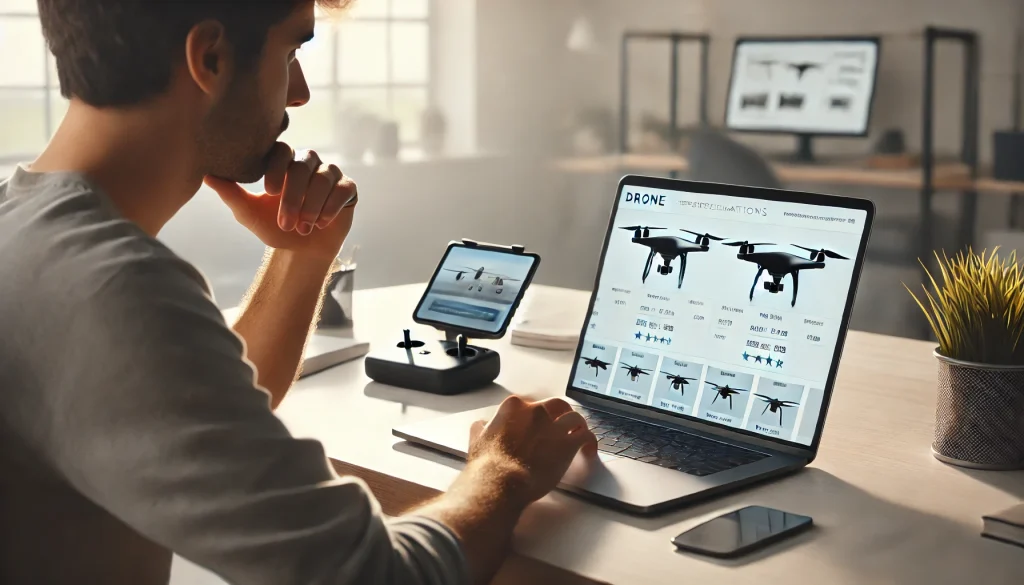
Recommendations Based on Specific Needs
1. For Beginners
For first-time flyers, simplicity and safety are key. Beginner-friendly drones should be affordable and easy to control while offering essential features to help you learn.
Recommended Drone: DJI Neo
Why:
- Affordable and beginner-friendly.
- Lightweight and safe for indoor or outdoor flying.
- 1080p HD camera suitable for casual photography.
Key Features:
- Flight time: 15 minutes.
- Simple controls and beginner modes for easy handling.
- Durable design to withstand minor crashes.
Best For:
Kids, hobbyists, and anyone exploring drones for the first time.
Pro Tip: Always practice flying in open spaces to improve your skills and avoid obstacles.
Check out our beginner’s guide to flying drones safely.
2. For Travelers
For on-the-go adventurers, portability and ease of use are essential. Drones for travelers should be lightweight, compact, and capable of capturing stunning visuals.
Recommended Drone: DJI Mini 4 Pro
Why:
- Foldable and lightweight design, under 250g, avoiding most regulatory restrictions.
- 4K HDR video recording with a 48MP camera for breathtaking visuals.
- Up to 45 minutes of flight time with an extended battery.
Key Features:
- Advanced omnidirectional obstacle avoidance for safer flights.
- GPS-assisted precision flying.
- Compact enough to fit in a small backpack.
Best For:
Travel vloggers, explorers, and enthusiasts who need professional-grade visuals in a portable package.
Learn how to maximize your travel drone’s performance on Tytorobotics.
3. For Professional Photographers
Professional-grade drones need advanced cameras, stabilization, and intelligent flight modes to deliver high-quality footage for demanding projects.
Recommended Drone: Autel EVO Nano 2
Why:
- Exceptional performance in low-light conditions with a 1/1.28-inch CMOS sensor.
- Adjustable aperture (f/1.9–f/11) for creative control.
- 6K video resolution for ultra-high-definition footage.
Key Features:
- Flight time: 42 minutes.
- Dynamic tracking for precise subject following.
- Lightweight and portable, yet packed with professional features.
Best For:
Photographers, filmmakers, and creatives who require superior visuals and flexibility.
4. For Recreational Use
Recreational users need drones that are fun to fly, easy to control, and reasonably priced. These drones are perfect for casual exploration and capturing memories.
Recommended Drone: HoverAir X1 Pro
Why:
- Combines 4K video capabilities with electronic image stabilization (EIS) for smooth footage.
- Affordable and durable, ideal for casual use.
- Lightweight and portable design.
Key Features:
- Flight time: 16 minutes.
- GPS-assisted flight with return-to-home functionality.
- Quick-swap battery design for extended fun.
Best For:
Weekend adventurers and hobbyists who want reliable performance without breaking the bank.
Explore the top recreational drones of 2024 on PCmag.
5. For Educational Purposes
Educational drones combine flying with programming, making them ideal for STEM learning. They support coding platforms and are safe for students.
Recommended Drone: Tello EDU (2024 Edition)
Why:
- Supports Scratch, Python, and Swift for hands-on coding experience.
- Affordable and safe for kids and students.
- Comes with advanced educational tools.
Key Features:
- Flight time: 15 minutes.
- Durable and lightweight design for classroom or outdoor use.
- Pre-programmed lesson plans for teachers.
Best For:
Students, teachers, and anyone interested in combining drone technology with STEM learning.
6. For Industrial Applications
Industrial users require specialized drones with advanced features for surveying, mapping, or inspections. These drones must offer durability, precision, and cutting-edge technology.
Recommended Drone: DJI Matrice 350 RTK
Why:
- Superior stability and payload capacity for industrial use.
- Real-time kinematic (RTK) positioning for precise mapping.
- Extended flight time and weather resistance.
Key Features:
- Flight time: 55 minutes.
- Interchangeable payloads for cameras, sensors, or tools.
- Long-range transmission for remote operations.
Best For:
Surveyors, engineers, and industrial professionals requiring robust and precise drones.
Warnings and Common Pitfalls
While buying and using drones can be an exciting experience, there are several common pitfalls and warnings to consider. Avoiding these mistakes will save you time, money, and potential frustration.
1. Buying from Unauthorized Sellers
Purchasing drones from unknown or unauthorized sellers increases the risk of:
- Receiving counterfeit products.
- Lacking manufacturer warranties or after-sales support.
- Missing critical updates for your drone.
Solution: Always buy from authorized retailers or the manufacturer’s official website.
Learn more about why authorized retailers matter on DroneLife.
2. Ignoring Local Drone Laws
Flying drones without understanding local regulations can lead to fines or confiscation of your device. Common issues include:
- Flying in no-fly zones like airports or national parks.
- Exceeding altitude limits.
- Failing to register your drone if required.
Solution: Research and comply with drone laws in your country.
Pro Tip: Use apps like AirMap to check no-fly zones in real time.
Check the latest FAA drone regulations on FAA’s official website.
3. Overlooking Product Inspections
Failing to inspect the drone before purchase, especially for used models, can result in purchasing a defective or damaged product.
What to Check:
- Physical integrity: Look for cracks, dents, or missing components.
- Functional testing: Ensure the camera, battery, and sensors work properly.
Solution: Always inspect the product thoroughly and ask for a flight log if purchasing a second-hand drone.
Read our guide on how to inspect a drone before buying.
4. Buying More Drone Than You Need
Over-investing in a high-end drone with features you’ll never use is a common pitfall, especially for beginners.
Example: A professional-grade drone like the DJI Mavic 3 Pro may overwhelm new users who only need basic functionality.
Solution: Choose a drone that fits your current skill level and upgrade as you gain experience.
5. Not Budgeting for Accessories
Drones often require additional accessories to function optimally. Many buyers overlook these costs, which can add up quickly.
Common Accessories:
- Spare batteries for extended flight time.
- Propeller guards for safety.
- Carrying cases for portability.
Pro Tip: Check for bundle deals that include these accessories at a discounted rate.
6. Underestimating the Importance of Practice
New users often dive straight into complex maneuvers without proper practice, leading to crashes or damages.
Solution: Start with:
- Practicing in open spaces.
- Using beginner modes or simulators to familiarize yourself with controls.
- Explore our beginner’s guide to safe drone flying.
7. Falling for Marketing Hype
Many drones boast impressive-sounding features that may not be practical for your needs.
Example:
- A drone with a 10km range may sound appealing, but if you’re only flying in a backyard, it’s unnecessary.
Solution: Focus on features that align with your personal goals and budget.
8. Neglecting Maintenance
Poor maintenance can shorten your drone’s lifespan. Common mistakes include:
- Not cleaning propellers or cameras.
- Using damaged batteries.
- Storing drones in humid or extreme conditions.
Solution: Regularly clean and inspect your drone, and store it in a dry, safe place.
Learn how to properly maintain your drone on Drone Rush.
9. Falling for “Too-Good-To-Be-True” Deals
Unrealistic discounts often signal scams or counterfeit products.
Solution: Stick to trusted retailers and avoid deals that seem too good to be true.
Summary of Warnings
By avoiding common pitfalls—like buying from unauthorized sellers, neglecting local laws, and underestimating maintenance—you can ensure a smoother and more enjoyable drone experience. Smart decisions upfront lead to fewer headaches down the line.
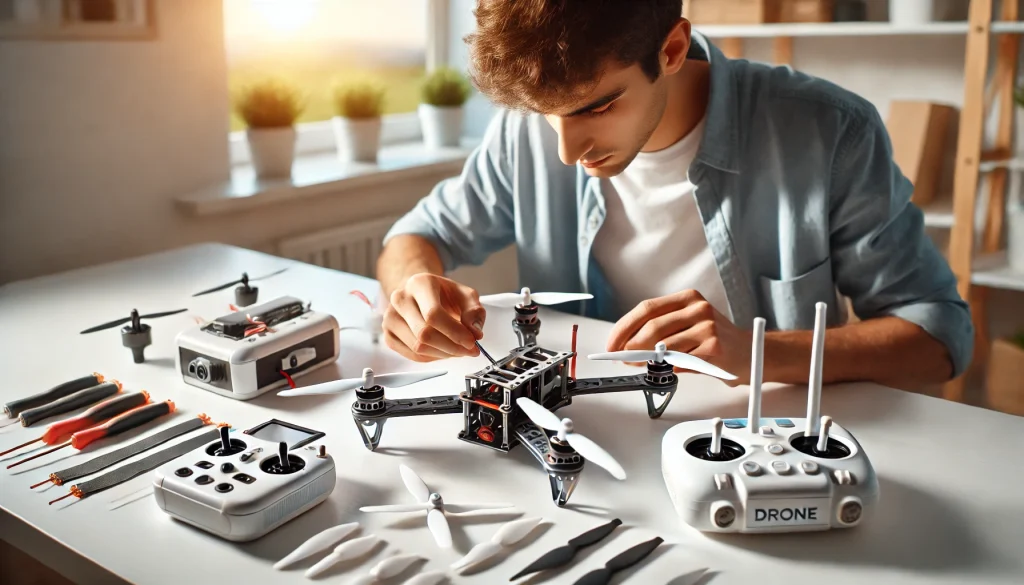
FAQs
1. What is the best drone for beginners?
For beginners, simplicity and affordability are key. The DJI Neo is an excellent choice because it is:
- Affordable and easy to control.
- Lightweight, making it safe for beginners.
- Equipped with basic features to help new users get started.
2. Do I need a license to fly a drone?
It depends on your location and the drone’s weight.
- In the U.S.:
- Drones weighing over 0.55 pounds (250g) require FAA registration.
- Commercial drone pilots must have a Part 107 certificate.
- Elsewhere: Regulations vary by country. Always check local laws before flying.
- Learn about FAA drone registration requirements on FAA’s official website.
3. What’s the average flight time for a drone?
Most consumer drones offer a flight time of 20–30 minutes on a single charge.
- Entry-level drones, like the Ryze Tech Tello, provide around 13 minutes.
- High-end drones, such as the DJI Mini 3 Pro, can fly for up to 47 minutes with an extended battery.
Pro Tip: Invest in spare batteries to extend your flight sessions.
4. Can I fly a drone indoors?
Yes, but there are precautions to take:
- Choose a lightweight drone with propeller guards, like the DJ Neo.
- Avoid flying near fragile objects or crowded spaces.
Note: Indoor flying can be a great way to practice your skills before heading outdoors.
5. How far can drones fly?
The range varies significantly between models:
- Beginner drones: Typically 100–300 meters.
- Mid-range drones: Around 2–5 kilometers.
- High-end drones: Up to 10 kilometers or more, like the DJI Mavic 3 Pro.
Safety Tip: Always keep your drone within your line of sight, even with long-range models.
6. What is the best drone for professional photography?
For professional-grade photography and videography, the Autel EVO Lite+ is a standout option:
- 6K video resolution for ultra-high-definition footage.
- Exceptional performance in low-light conditions.
- Adjustable aperture for greater creative control.
- Discover more about the best drones for photography in our detailed guide.
7. Can drones be used for educational purposes?
Absolutely! Educational drones, like the Tello EDU, are designed to teach programming and other STEM skills.
- Supports Scratch, Python, and Swift coding.
- Perfect for students and hobbyists exploring technology.
Pro Tip: These drones are safe for kids and provide hands-on learning experiences.
8. What accessories should I buy with my drone?
Essential drone accessories include:
- Spare batteries: For extended flight sessions.
- Propeller guards: To protect your drone from damage.
- Carrying cases: For safe and easy transport.
- ND filters: To enhance photography in bright conditions.
- Check out our list of must-have drone accessories for every user.
9. Are there any risks with buying used drones?
Buying used drones can save money, but it comes with risks:
- Potential hidden damages or wear.
- Lack of warranties or after-sales support.
Tips for Buying Used Drones:
- Inspect the drone thoroughly.
- Ask for flight logs to check for crashes or malfunctions.
- Only buy from trusted sources.
- Learn about what to check when buying a used drone on Drone Enthusiast.
10. What are the most common mistakes new drone pilots make?
- Skipping practice: Leads to crashes and accidents.
- Flying in restricted areas: Results in fines or confiscation.
- Ignoring battery care: Reduces lifespan and flight time.
Pro Tip: Start with beginner modes and practice in open, obstacle-free areas.
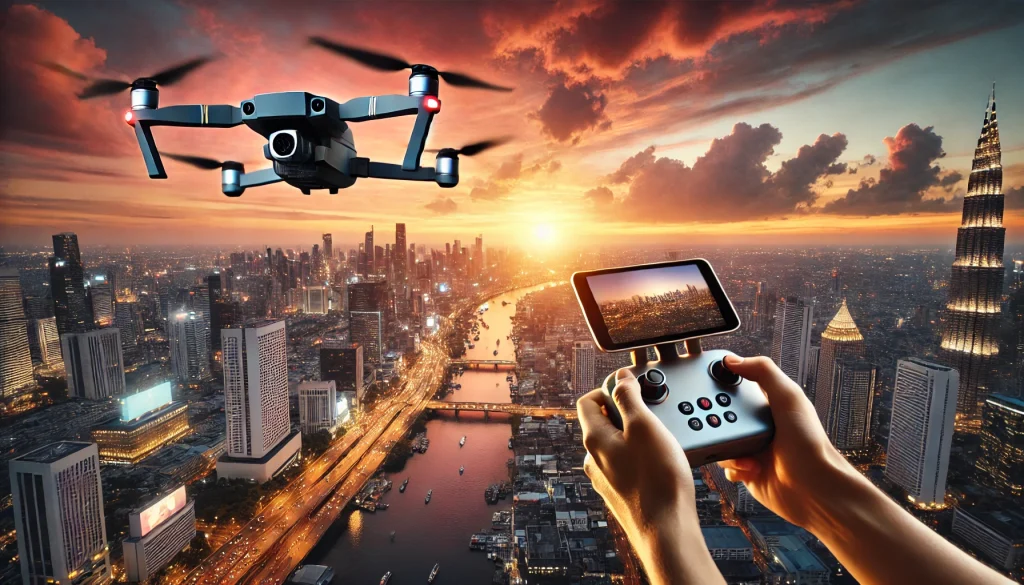
Conclusion
Buying a drone can seem like a daunting process, but with the right guidance, you can make a confident and informed decision. By understanding your personal needs, evaluating key factors like camera quality, flight time, and ease of use, and comparing the top options on the market, you’ll be well-equipped to find the perfect drone for your goals.
Now that you’re armed with all the knowledge to choose the best drone, it’s time to take the next step.
Click below to explore our top recommendations and detailed reviews How to use Drone for Beginners.
Don’t wait—your perfect drone adventure is just a flight away!





















